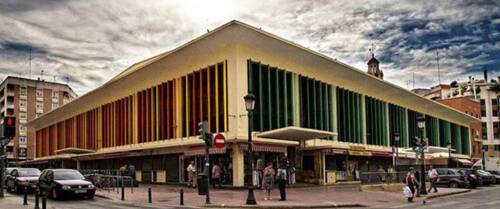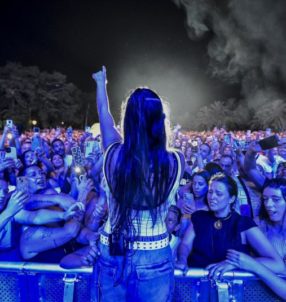##The elegantly scruffy neighbourhood of Ruzafa was first incorporated into the city of Valencia about 130 years ago. Even in that time it has often been seen as being a bit off the beaten track. Now, however, while more central areas become increasingly franchised, sanitised and expensive, it’s Ruzafa which is fast cementing its place as one of the most popular neighbourhoods in the city for those looking for an enjoyably different night out.
Although, admittedly, it is not something that immediately springs to mind when entering the barrio through the pedestrian tunnel under the Gran Via de Germanias, Ruzafa or Russafa takes its name from an ancient Arabic word meaning something like ‘scented garden’. For visitors, ‘Ruzafa’ is the Spanish spelling and ‘Russafa’ is the Valencia spelling. Hixem (or Hisham), the great Omeya Caliph of Damascus, built a garden which he called Russafa between the Euphrates and the city of Palmyra in the early 8th century and such gardens were built all over the Arab world as places of beauty and quiet around the palaces of the Moorish kings and princes. The area of Ruzafa in Valencia was a country retreat or ‘munya’ built around 796 for Prince Omeya Abd Allah al-Balansi whose lands extended into Catalonia and Murcia. In the 13th century, the Moorish poet al-Saqundi described the Valencia Ruzafa as one of the most beautiful places on Earth.
Sadly, nowadays not even a stone remains from Ruzafa’s Moorish past. At the centre of barrio is a square dominated by two buildings, the 15th century church of San Valero Obispo y San Vicente Martír and the recently garishly painted 1960s market building. They make up a typically Ruzafa juxtaposition of crumbling past grandeur and the ugly practicalities of modern life. According to tradition, this was the exact spot where the keys of the city were handed over to King Jaime by the defeated Moorish king Aben Zayyan after the re-conquest. It was also the place where the last victim of the Inquisition in Valencia was burned at the stake in 1826. He was an unfortunate schoolteacher named Cayetano Ripoll whose only crime was a dangerous heretic passion for humanism, philanthropy and Rousseau. The scandal and indignation caused by his execution led in great part to the final dissolution of the Inquisition just a few years later.
The Ruzafa we see today was mostly designed and built at the end of the 19th century after the neighbourhood became officially part of the city in 1877. The barrio is divided into two distinct areas. Between the market and the Avenida del Antiguo Reino is the posher end (the streets are wider and often lined with trees, the houses more elegant) which was built for the bourgeois children of rich merchants and those who’d made their cash from the railways. From the market down to the Estación del Norte train station is a distinctly more working-class area (very few trees, narrower streets and more modest houses), which was originally built for the railway workers.
It’s this part of Ruzafa which gives the area its personality and which has given life to an eclectic array of restaurants, bars, shops and night spots, with new ones springing up all the tine. As one local barman pointed out, “Ruzafa is at that exciting place where the Carmen was in the ‘80s and ‘90s”. There’s a buzz and a sense of individuality without losing sight of the barrio’s essential feel. Bodega El Mercat on C/ del Cura Femenia, 2 is a restaurant which still keeps the feel and decoration of its previous incarnation as an old olive oil shop and the Ubik Café on C/ Literato Azorín, 13 is a spacious and cosmopolitan bookshop/ bar with second-hand books to read and a children’s play area.
Alongside the café-bar bookshops there is a wide range of entertainment and cuisine to choose from. Quality live jazz music can be enjoyed at Café Mercedes Jazz on C/ Sueca, 27. There are salsa clubs, North African tea rooms, halal butchers, Chinese food shops, specialist guitar shops, a shop which sells only honey, vegetarian shops and restaurants of every type. A number of hip nightclubs like Piccadilly C/ dels Tomasos, 14 have moved to Ruzafa and provide an all-night party for clubbers with electro, rock ’n’ roll and more. Highly popular bars like Rojo and Café Pessoa , both on Literato Azorín, have names that reflect their bohemian clientele. The varied character of Ruzafa has made the area a popular place for a night out and, despite the fact that it’s almost impossible to park, it is an increasingly popular place to find a flat.
This part of town is characterised by a population mix of families and older people who’ve lived in the barrio all their lives, people moving into the barrio’s newly restored buildings, students, and (mostly) North African and Asian immigrants. Despite this potentially explosive cocktail of a traditional working-class area with an increasingly visible immigrant presence, Ruzafa has largely managed to avoid problems and tensions other similar neighbourhoods around Europe have suffered. This is partly due to good attitudes on both sides. The local mosque has gone out of its way on a number of occasions to cooperate with the community and local residents have strongly rejected any attempts by reactionaries to stir things up. Another factor might be the social position of many of the immigrants. One lifelong resident told us, “The non-Spanish population here, especially the North Africans, is for the most part very well integrated. There are no problems unless you look for them. Maybe it’s because many of the people who’ve come here already have established social networks, and have been able to set up businesses, open up shops and generally bring more life to the barrio.”
Things may change in the future. There are fears that the inevitable gentrification of the area, accelerated by the Central Park development, will sap some of the barrio’s soul and may cause tension as lifelong residents and immigrants alike are forced out. Until that happens, do your best to enjoy Ruzafa’s modern-day Valencia version of Prince Omeya Abd Allah’s garden of delights.
David Rhead and José Marín
Related Post
This site uses Akismet to reduce spam. Learn how your comment data is processed.

























Leave a comment